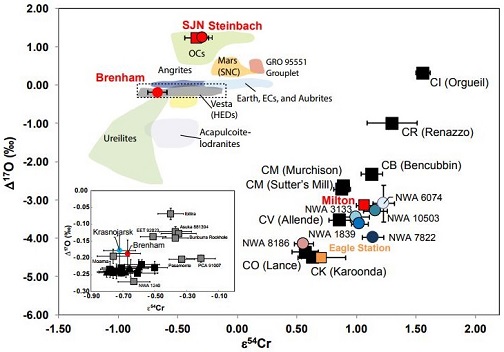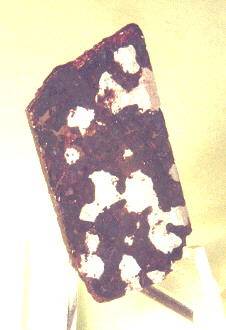Steinbach
Iron, IVA-an
(silica-rich orthopyroxeniteA rock composed primarily of orthopyroxene. Non-terrestrial orthopyoxenites include diogenites and a single martian meteorite, ALH 84001, that was found in the Allan Hills region of Antarctica in 1984. ALH 84001 is a cumulate rock consisting of 97% coarse-grained, Mg-rich orthopyroxene, with small amounts of plagioclase, chromite, and carbonate. It Click on Term to Read More, possibly LL chondriteOrdinary chondrites ("low Fe" / "low metal") with only 1 to 3% free metal. Their olivine is more Fe-rich than in the other ordinary chondrites (Fa27-32), implying that the LL types must have formed under more oxidizing conditions than their H or L cousins. Orthopyroxene compositions are also Fe-the rich Click on Term to Read More related)
Found 1724
50° 30′ N., 12° 30′ E. approx. A unique meteoriteWork in progress. A solid natural object reaching a planet’s surface from interplanetary space. Solid portion of a meteoroid that survives its fall to Earth, or some other body. Meteorites are classified as stony meteorites, iron meteorites, and stony-iron meteorites. These groups are further divided according to their mineralogy and Click on Term to Read More 40 cm in diameter was found in Karl-Marx-Stadt, Germany, and classified as a IVA-anomalous stony-iron. Steinbach is possibly associated with a fallMeteorite seen to fall. Such meteorites are usually collected soon after falling and are not affected by terrestrial weathering (Weathering = 0). Beginning in 2014 (date needs confirmation), the NomComm adopted the use of the terms "probable fall" and "confirmed fall" to provide better insight into the meteorite's history. If Click on Term to Read More near Grimma, Germany around 1550. Three separate masses were found including a 1.0 kg mass found in Gotha in 1724, an 86.5 kg mass found in Rittersgrün in 1833, and a 10.5 kg mass found in Breitenbach in 1861, for a combined weight of 98 kg.

click on image for a magnified view Diagram credit: Sanborn et al., 49th LPSC, #1780 (2018) The low Ni content is thought to be a result of Fe dilution derived both from dissociation of FeS and by reductionOxidation and reduction together are called redox (reduction and oxidation) and generally characterized by the transfer of electrons between chemical species, like molecules, atoms or ions, where one species undergoes oxidation, a loss of electrons, while another species undergoes reduction, a gain of electrons. This transfer of electrons between reactants Click on Term to Read More of FeO (Wasson et al., 2006). A lower than normal Ge and Ga content for this iron suggests their loss through high temperatures in an open systemDefinable part of the universe that can be open, closed, or isolated. An open system exchanges both matter and energy with its surroundings. A closed system can only exchange energy with its surroundings; it has walls through which heat can pass. An isolated system cannot exchange energy or matter with. Melting and differentiationA process by which a generally homogeneous chondritic body containing mostly metal, silicates and sulfides will melt and form distinct (differentiated) layers of different densities. When the melting process continues for a long enough period of time, the once chondritic body will re-partition into layers of different composition including Click on Term to Read More of the iron and its subsequent drainage to form a core was likely initiated by a large impact(s) onto a porous L–LL-type asteroid between ~20 and 160 km in diameter, rather than by radiogenic heating (26Al, 60Fe) alone (Wasson and Kunihiro, 2004; Kunihiro et al., 2004). It was calculated that Steinbach contains metal and silicates more evolved than in other silica-bearing meteorites, consistent with a greater depth of penetration as a melt phase into fractures in the metallic core. Steinbach was the latest of the silica-bearing meteorites to form on the IVA parent bodyThe body from which a meteorite or meteoroid was derived prior to its ejection. Some parent bodies were destroyed early in the formation of our Solar System, while others like the asteroid 4-Vesta and Mars are still observable today. Click on Term to Read More, which occurred after ~77% core crystallation (the others formed at or before the 30% fractional crystallizationPhysical or chemical process or action that results in the formation of regularly-shaped, -sized, and -patterned solid forms known as crystals. Click on Term to Read More stage). Wasson et al. (2006) posited that crystallization might have occurred from the center of the core outward, with both stony-iron lithologies forming near the core–mantleMain silicate-rich zone within a planet between the crust and metallic core. The mantle accounts for 82% of Earth's volume and is composed of silicate minerals rich in Mg. The temperature of the mantle can be as high as 3,700 °C. Heat generated in the core causes convection currents in Click on Term to Read More boundary. In light of all the available data, multiple plausible models for the formation of Steinbach and the other silica-bearing IVA iron meteorites have been proposed. A scenario based on the estimated cooling rate data of metal and orthopyroxene, and another based on O-isotope thermometry (Wang et al., 2004), suggest that Steinbach and two other paired silica-bearing IVA iron meteorites, São João Nepomuceno and Descoberto (Zucolotto and Monteiro, 2012), initially cooled from peak temperatures at a slow rate following accretionAccumulation of smaller objects into progressively larger bodies in the solar nebula leading to the eventual formation of asteroids, planetesimals and planets. The earliest accretion of the smallest particles was due to Van der Waals and electromagnetic forces. Further accretion continued by relatively low-velocity collisions of smaller bodies in the Click on Term to Read More and heating by radiogenic nuclideA nuclear species characterized by Z protons and N neutrons. Click on Term to Read More decay. A molten metallic core would have been quickly formed through gravitational drainage. An in-depth analysis of Steinbach by Ruzicka and Hutson (2006) led them to suggest that this precursor body was disrupted during a catastrophic collision, with some portion of the original body being re-accreted to form a random mixture of molten metal and silicates. From the small number of silicated IVA meteorites known, it is probable that this re-accreted body was mostly composed of the metallic core component. This impact event disrupted most of the silicate mantle and caused rapid cooling (~100°C/hr) at higher temperatures, initiating the production of clinobronzite from protopyroxene, as well as hindering metal–silicate separation. After the remaining silicates were crystallized (by 1240°C), slow cooling persisted down to temperatures as low as ~350°C, with cooling rate variations among different samples attributable to differences in burial depth. Cooling of this mantle-less metallic body is thought to have progressed from the surface inward, and metallographic cooling models for the IVA meteorites are consistent with such a scenario given an asteroidal diameter of ~300 km. In paleomagnetic studies of Steinbach and São João Nepomuceno, Bryson et al. (2017) found evidence for a strong natural remanent magnetization in matrixFine grained primary and silicate-rich material in chondrites that surrounds chondrules, refractory inclusions (like CAIs), breccia clasts and other constituents. Click on Term to Read More metal in Steinbach. This is consistent with the hypothesis and models of an unmantled, inwardly solidifying core that generated a dynamo (probably through non-concentric solidification) with a directionally varying field of ≥100 µT. During the high temperature stage (1450–1490°C) of this proposed disruption/re-accretion event, the solid olivine-rich mantle was segregated from the remaining molten phases, silicate melt was injected into metallic melt, a significant degree of reduction induced the loss of substantial FeO, and some volatileSubstances which have a tendency to enter the gas phase relatively easily (by evaporation, addition of heat, etc.). losses occurred. Although a rapid cooling phase 207–375 m.y. ago attests to an additional disruption, the silicates in Steinbach show no shock effects, a factor which would need to be accounted for provided there were further impacts. An alternative scenario was developed by Wasson et al. (2006) in which they dispute the possibility of an impact-scrambling model, and suggest instead that this silicated IVA group experienced a typical cooling scenario with no large cooling-rate deviations as evidenced by the size of cloudy taenite islands. They propose that a late impact event converted some orthopyroxene into clinopyroxene. However, more exacting measurements of high-Ni particles in the cloudy zone by Goldstein et al. (2009) indicate a much different thermal history for the IVA irons (see further details and a likely formation scenario on the Gibeon page. Two other IVA irons, Gibeon and Bishop Canyon, contain tridymite veins that were formed from vapor deposition (or possibly melt injection) of a SiO-rich source. The specimen of Steinbach pictured above is a 5.8 g partial slice showing the FeNi-metal network that encloses granular aggregates of low-Ca pyroxene and tridymite. The porosityThe volume percentage of a rock that consists of void space. Vesicular porosity is a type of porosity resulting from the presence of vesicles, or gas bubbles, in igneous rock such as the pumice presented here. Vesicular porosity is very rare in meteorites and is often associated with slag, one Click on Term to Read More of Steinbach was determined by M. Strait (2010) to range from 0% for the metallic component, to 3.56% for the silicate component. The photo below is a 631 g slice of São João Nepomuceno, shown courtesy of the Jay Piatek Collection.

Photo courtesy of the J. Piatek Collection







